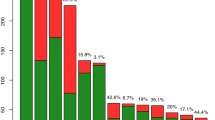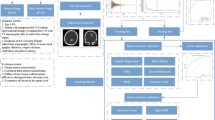Abstract
Objectives
Prediction of intracranial aneurysm rupture is important in the management of unruptured aneurysms. The application of radiomics in predicting aneurysm rupture remained largely unexplored. This study aims to evaluate the radiomics differences between ruptured and unruptured aneurysms and explore its potential use in predicting aneurysm rupture.
Methods
One hundred twenty-two aneurysms were included in the study (93 unruptured). Morphological and radiomics features were extracted for each case. Statistical analysis was performed to identify significant features which were incorporated into prediction models constructed with a machine learning algorithm. To investigate the usefulness of radiomics features, three models were constructed and compared. The baseline model A was constructed with morphological features, while model B was constructed with addition of radiomics shape features and model C with more radiomics features. Multivariate analysis was performed for the ten most important variables in model C to identify independent risk factors. A simplified model based on independent risk factors was constructed for clinical use.
Results
Five morphological features and 89 radiomics features were significantly associated with rupture. Model A, model B, and model C achieved the area under the receiver operating characteristic curve of 0.767, 0.807, and 0.879, respectively. Model C was significantly better than model A and model B (p < 0.001). Multivariate analysis identified two radiomics features which were used to construct the simplified model showing an AUROC of 0.876.
Conclusions
Radiomics signatures were different between ruptured and unruptured aneurysms. The use of radiomics features, especially texture features, may significantly improve rupture prediction performance.
Key Points
• Significant radiomics differences exist between ruptured and unruptured intracranial aneurysms.
• Radiomics shape features can significantly improve rupture prediction performance over conventional morphology-based prediction model. The inclusion of histogram and texture radiomics features can further improve the performance.
• A simplified model with two variables achieved a similar level of performance as the more complex ones. Our prediction model can serve as a promising tool for the risk management of intracranial aneurysms.





Similar content being viewed by others
Abbreviations
- CTA:
-
Computed tomography angiography
- GLCM:
-
Gray-level co-occurrence matrix
- GLDM:
-
Gray-level dependence matrix
- GLRLM:
-
Gray-level run length matrix
- GLSZM:
-
Gray-level size zone matrix
- NGTDM:
-
Neighboring gray tone difference matrix
References
Li MH, Chen SW, Li YD et al (2013) Prevalence of unruptured cerebral aneurysms in Chinese adults aged 35 to 75 years: a cross-sectional study. Ann Intern Med 159:514–521. https://doi.org/10.7326/0003-4819-159-8-201310150-00004
Morita A, Kirino T, Hashi K et al (2012) The natural course of unruptured cerebral aneurysms in a Japanese cohort. N Engl J Med 366:2474–2482. https://doi.org/10.1056/NEJMoa1113260
Wiebers DO, Whisnant JP, Huston J 3rd et al (2003) Unruptured intracranial aneurysms: natural history, clinical outcome, and risks of surgical and endovascular treatment. Lancet. 362:103–110. https://doi.org/10.1016/s0140-6736(03)13860-3
Korja M, Kivisaari R, Rezai Jahromi B, Lehto H (2017) Natural history of ruptured but untreated intracranial aneurysms. Stroke. 48:1081–1084. https://doi.org/10.1161/STROKEAHA.116.015933
Xiang J, Natarajan SK, Tremmel M et al (2011) Hemodynamic-morphologic discriminants for intracranial aneurysm rupture. Stroke. 42:144–152. https://doi.org/10.1161/STROKEAHA.110.592923
Varble N, Tutino VM, Yu J et al (2018) Shared and distinct rupture discriminants of small and large intracranial aneurysms. Stroke. 49:856–864. https://doi.org/10.1161/STROKEAHA.117.019929
Cebral JR, Mut F, Weir J, Putman C (2011) Quantitative characterization of the hemodynamic environment in ruptured and unruptured brain aneurysms. AJNR Am J Neuroradiol 32:145–151. https://doi.org/10.3174/ajnr.A2419
Takao H, Murayama Y, Otsuka S et al (2012) Hemodynamic differences between unruptured and ruptured intracranial aneurysms during observation. Stroke. 43:1436–1439. https://doi.org/10.1161/STROKEAHA.111.640995
Zhang X, Karuna T, Yao ZQ et al (2019) High wall shear stress beyond a certain range in the parent artery could predict the risk of anterior communicating artery aneurysm rupture at follow-up. J Neurosurg 131:868–875. https://doi.org/10.3171/2018.4.JNS173179
Miura Y, Ishida F, Umeda Y et al (2013) Low wall shear stress is independently associated with the rupture status of middle cerebral artery aneurysms. Stroke. 44:519–521. https://doi.org/10.1161/STROKEAHA.112.675306
Tada Y, Wada K, Shimada K et al (2014) Roles of hypertension in the rupture of intracranial aneurysms. Stroke. 45:579–586. https://doi.org/10.1161/STROKEAHA.113.003072
Can A, Castro VM, Dligach D et al (2018) Lipid-lowering agents and high HDL (high-density lipoprotein) are inversely associated with intracranial aneurysm rupture. Stroke. 49:1148–1154. https://doi.org/10.1161/STROKEAHA.117.019972
Can A, Castro VM, Ozdemir YH et al (2018) Alcohol consumption and aneurysmal subarachnoid hemorrhage. Transl Stroke Res 9:13–19. https://doi.org/10.1007/s12975-017-0557-z
Can A, Castro VM, Ozdemir YH et al (2017) Association of intracranial aneurysm rupture with smoking duration, intensity, and cessation. Neurology. 89:1408–1415. https://doi.org/10.1212/WNL.0000000000004419
Juvela S (2019) Growth and rupture of unruptured intracranial aneurysms. J Neurosurg 131:843–851. https://doi.org/10.3171/2018.4.JNS18687
Greving JP, Wermer MJ, Brown RD Jr et al (2014) Development of the PHASES score for prediction of risk of rupture of intracranial aneurysms: a pooled analysis of six prospective cohort studies. Lancet Neurol 13:59–66
Bijlenga P, Gondar R, Schilling S et al (2017) PHASES score for the management of intracranial aneurysm: a cross-sectional population-based retrospective study. Stroke. 48:2105–2112
Shi Z, Hu B, Schoepf UJ, Savage RH et al (2020) Artificial intelligence in the management of intracranial aneurysms: current status and future perspectives. AJNR Am J Neuroradiol 41(3):373–379
Liu QL, Jiang P, Jiang YH et al (2019) Prediction of aneurysm stability using a machine learning model based on PyRadiomics-derived morphological features. Stroke. 50:2314–2321. https://doi.org/10.1161/STROKEAHA.119.025777
Zhang Y, Ma C, Liang S et al (2018) Morphologic feature elongation can predict occlusion status following pipeline embolization of intracranial aneurysms. World Neurosurg 119:934–940. https://doi.org/10.1016/j.wneu.2018.08.007
Thompson BG, Brown RD Jr, Amin-Hanjani S et al (2015) Guidelines for the management of patients with unruptured intracranial aneurysms: a guideline for healthcare professionals from the American Heart Association/American Stroke Association. Stroke. 46(8):2368–2400
Liu J, Chen Y, Lan L et al (2018) Prediction of rupture risk in anterior communicating artery aneurysms with a feed-forward artificial neural network. Eur Radiol 28:3268–3232. https://doi.org/10.1007/s00330-017-5300-3
Kim HC, Rhim JK, Ahn JH et al (2019) Machine learning application for rupture risk assessment in small-sized intracranial aneurysm. J Clin Med 8:683. https://doi.org/10.3390/jcm8050683
Detmer FJ, Chung BJ, Mut F et al (2018) Development and internal validation of an aneurysm rupture probability model based on patient characteristics and aneurysm location, morphology, and hemodynamics. Int J Comput Assist Radiol Surg 13:1767–1779. https://doi.org/10.1007/s11548-018-1837-0
Skodvin TØ, Johnsen LH, Gjertsen Ø, Isaksen JG, Sorteberg A (2017) Cerebral aneurysm morphology before and after rupture: nationwide case series of 29 aneurysms. Stroke. 48:880–886. https://doi.org/10.1161/STROKEAHA.116.015288
Dhar S, Tremmel M, Mocco J et al (2008) Morphology parameters for intracranial aneurysm rupture risk assessment. Neurosurgery. 63:185–197. https://doi.org/10.1227/01.NEU.0000316847.64140.81
Zwanenburg A, Leger S, Vallières M, Löck S (2016) Image biomarker standardisation initiative - feature definitions. In eprint arXiv:1612.07003
Molinaro AM, Simon R, Pfeiffer RM (2005) Prediction error estimation: a comparison of resampling methods. Bioinformatics 21:3301–3307. https://doi.org/10.1093/bioinformatics/bti499
Saito T, Rehmsmeier M. The precision-recall plot is more informative than the ROC plot when evaluating binary classifiers on imbalanced datasets. PloS One. 2015;10(3)
Demšar J (2006) Statistical comparisons of classifiers over multiple data sets. J Mach Learn Res 7(Jan):1–30
George E, Giannopoulos AA, Aghayev A et al (2016) Contrast inhomogeneity in CT angiography of the abdominal aortic aneurysm. J Cardiovasc Comput Tomogr 10:179–183. https://doi.org/10.1016/j.jcct.2015.11.006
Aghayev A, Giannopoulos AA, Gronsbell J et al (2018) Common first-pass CT angiography findings associated with rapid growth rate in abdominal aorta aneurysms between 3 and 5 cm in largest diameter. AJR Am J Roentgenol 210:431–437. https://doi.org/10.2214/AJR.17.18094
Berenguer R, Pastor-Juan MD, Canales-Vázquez J et al (2018) Radiomics of CT features may be nonreproducible and redundant: influence of CT acquisition parameters. Radiology. 288:407–415. https://doi.org/10.1148/radiol.2018172361
Chen T, Li X, Li Y et al (2019) Prediction and risk stratification of kidney outcomes in IgA nephropathy. Am J Kidney Dis 74(3):300–309
Park A, Chute C, Rajpurkar P et al (2019) Deep learning–assisted diagnosis of cerebral aneurysms using the HeadXNet model. JAMA Netw Open 2(6):e195600
Funding
Funding was provided through the National Health and Medical Research Council (NHMRC) Project (Grant ID: APP1157566).
Author information
Authors and Affiliations
Corresponding author
Ethics declarations
Guarantor
The scientific guarantor of this publication is Yi Qian who works in Macquarie University.
Conflict of interest
The authors of this manuscript declare no relationships with any companies whose products or services may be related to the subject matter of the article.
Statistics and biometry
No complex statistical methods were necessary for this paper.
Informed consent
Written informed consent was waived by the Institutional Review Board.
Ethical approval
Approval for this study was obtained from the local Institutional Review Board of Macquarie University.
Methodology
• retrospective
• cross sectional study
• performed at one institution
Additional information
Publisher’s note
Springer Nature remains neutral with regard to jurisdictional claims in published maps and institutional affiliations.
Electronic supplementary material
ESM 1
(DOCX 801 kb)
Rights and permissions
About this article
Cite this article
Ou, C., Chong, W., Duan, CZ. et al. A preliminary investigation of radiomics differences between ruptured and unruptured intracranial aneurysms. Eur Radiol 31, 2716–2725 (2021). https://doi.org/10.1007/s00330-020-07325-3
Received:
Revised:
Accepted:
Published:
Issue Date:
DOI: https://doi.org/10.1007/s00330-020-07325-3




